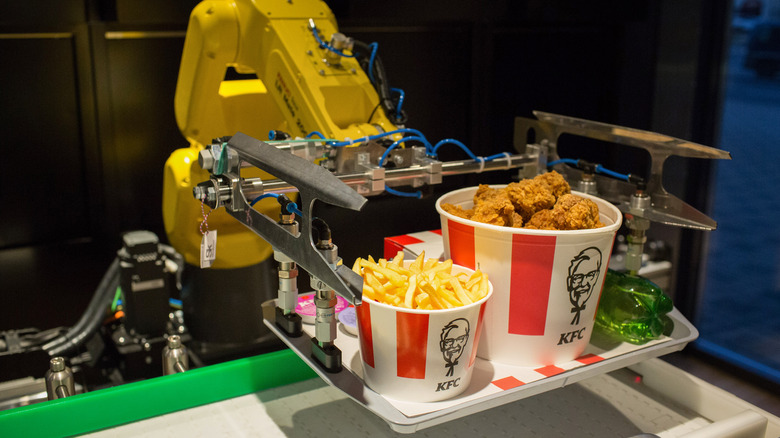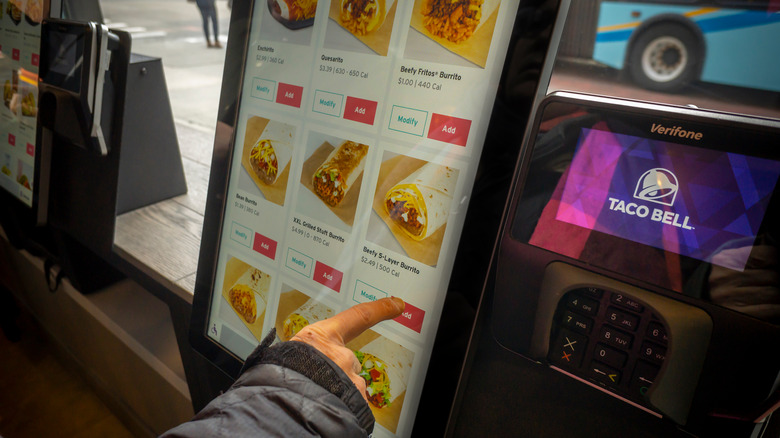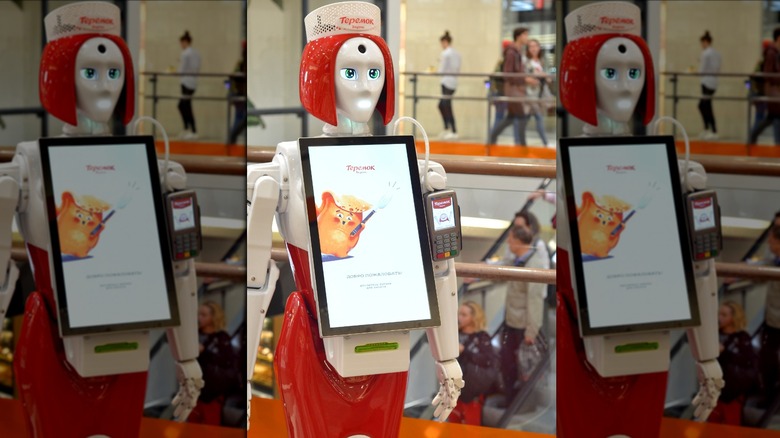The Big Ways Robots Are Quietly Taking Over Fast Food
It looks like more and more, robots will continue to infiltrate the fast food industry. In the latest case, as CNBC reported last week, 10 McDonald's restaurants in Chicago are testing voice ordering technology in drive-thrus. So far, only about one-fifth of the orders need to be taken by humans. The computers have an 85% success rate for accurately taking down orders for Big Macs and fries.
However, McDonald's CEO Chris Kempczinski cautioned against over-enthusiasm while speaking at Alliance Bernstein's Strategic Decisions conference: "Now there's a big leap from going to 10 restaurants in Chicago to 14,000 restaurants across the U.S., with an infinite number of promo permutations, menu permutations, dialect permutations, weather — and on and on and on."
When the test was first announced in March, Lucy Brady, McDonald's chief digital customer engagement officer, explained to CNN the reasoning behind this initiative: "Humans sometimes forget to greet people, they forget, they make mistakes, they don't hear as well. A machine can actually have a consistent greeting and remain calm under pressure." The algorithmic-like food and service that some McDonald's fans expect might go well with tech-based ordering systems. After all, the complaints some people lob at fast food chains tend to revolve around poor customer service or orders that have fallen to the vagaries of chance (via Forbes). The fast food industry is primed for automation.
Taco Bell, KFC, and Domino's are turning to robots
These tests conducted in Chicago are only one instance in the last few years of the technological arms race conducted by fast food brands.
In October 2020, My Smart Choice revealed an agreement between KFC and Hyundai Robotics to develop chicken-cooking robots. The point the piece made was that in addition to the aforementioned reasons for fast food companies to self-automate, the appeal for robotics companies like Hyundai is that the delicacies of food preparation would prove a great test for their designs. Following a recipe doesn't differ from following an algorithm, so the real difficulty these companies are seeking to overcome is the dexterity of the mechanical parts involved. If successful, robot cooks would prove to be valuable — they can work long hours and don't require sick days.
In April, innovation spread from the kitchen to include how one orders and receives their meals. Taco Bell debuted a new Cantina in Times Square which, as it described to Mashed in a press release, offers both in-store ordering from touch screens and cubby holes for take-out orders, further streamlining the pedestrian-focused Cantinas with Taco Bell's general drive-thru ambitions. Domino's, however, continued to stay true to its "tech company that sells pizza" image by investing in autonomous pizza delivery cars. In the press release shared by Associated Press, the delivery bots, made by tech company Nuro, had their debut in Houston, though plans for further expansion have not been announced. With all three of these shakeups, the biggest breakthrough is how each chain is replacing bodies with bolts.
How will tech-based innovation affect fast food workers?
The conversation surrounding these technologies strikes the expected optimism of someone saying facts that will not directly affect them. "Taking orders is thankless," Rob Carpenter, the founder of the conversational platform design company Valyant AI, stated to Today. "It's one of the least desired jobs of fast food employees." While customer-facing work in the service industry can be challenging, it's tough to say how this will impact the workforce.
The general hope, as Jamie Richardson, the VP of White Castle, told CNN, is that automating these less desirable jobs allows for a different focus. In Richardson's vision, however, that focus is greater attention on customer service and hospitality. Now, while Carpenter is talking only about automated drive-thrus, the same technology could be applied to in-house order taking.
How companies will deal with implementing this radical change to labor will vary, of course. The Boss Magazine brings up Shake Shack as an example. They have in-house kiosks and online ordering, but also provide "hospitality champs" to help customers through the novel process. Other roles outlined by the piece are various supporting functions for the machines, such as refilling and repairing. Note, however, that a lot of the real labor would still end up being done by humans, but just not in the view of the customer. That said, with the recent labor shortage in fast food, as covered by Prospect, perhaps these brands have no choice but automation.


